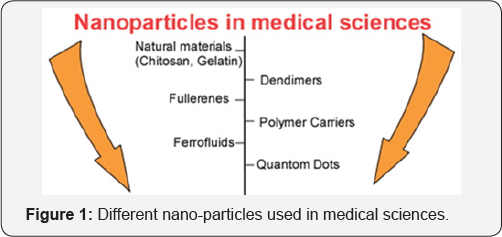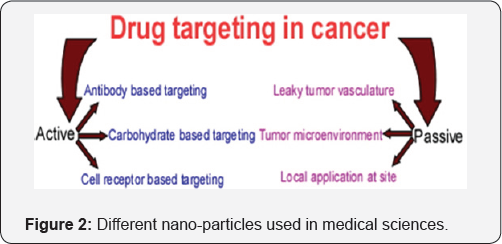Exploring a New Era of Targeted Nano-Therapeutics Hg as a Promising Approach to Battle Cancer-Juniper publishers
Global Journal of Nanomedicine-Juniper publishers
Introduction
Cancer is a complex genetic disease [1] posing a major threat to mankind worldwide. Though major development has been observed in the field of chemotherapy in the recent years but chemotherapy suffers due to lack of selectivity and resistance to multiple drugs. Thus exploration of versatile field of nanotechnology may help in the introduction of alternative targeted therapy for battling cancer. Nanoparticles provide a perfect platform for drug delivery to cancer cells. In fact use of nanoparticles provides some major advantages which include
a. Targeted delivery to the tissue of interest,
b. Reduction in overall side effects of the drug, and
c. Increased biocompatibility [2].

Thus use of engineered nanoparticles can enhance the efficacy of the drug and also minimize the side-effects in cancer bearers. Various carrier systems are now being exploited to develop suitable drug delivery system and have wide application in medical sciences [3] (Figure 1).

Targeting of nano-particles to cancer cells has gained prime importance as alternative therapeutic options for treating cancer. The basic objective is to target the drug to the cancer cells leading to tumor regression leaving the normal tissues unaffected. Nano-conjugation of drug posses several advantages, they help in enhancement of solubility and stability of the drug and the release of the drug in a more controlled manner. In addition surface modification of the nano-particle enhances their blood circulation, and also improves their biodistribution profile [4,5]. In fact surface functionalization by PEG increases its circulation time and avoids clearance by the reticuloendothelial system [6-8]. On attachment of tumor-targeted ligand on the nano-particle surface results in enhanced uptake in tumor tissue [9,10]. The small size is also plays a major role in delivery of drug to the tumor tissues [11]. Due to all these advantages the nanotherapeutics show much targeted delivery to tumor tissues with reduced systemic toxicity to the surrounding tissues (Figure 2).
Nano-particles can be targeted to tumor tissue by either active or passive targeting approach. The nano-particles which are smaller in size with a diameter less than 200nM can easily enter the tumor tissue through EPR effect [12]. These nanoparticles are normally cleared through the liver. Though this passive process of drug targeting is now most commonly used in the clinics yet there are certain limitations to this process also. In certain tumors that do not exhibit the EPR effect reaching the tumor site through passive targeting is difficult [13,14]. Furthermore lack of uniformity of blood vessel permeability around the tumor may also result in improper distribution of drug in the tumor tissue [15]. Additionally a failure to control the delivery of drug to the tissue might also result in multi-drug resistance in the body of the host [16].
Thus to overcome these drawbacks passive targeting is often used with active targeting. Active targeting helps in the retention of the nano-therapeutics in the tissue for enhanced drug activity. Normally active targeting is achieved by tagging the nano-therapeutic with a ligand which is specific for cell surface receptor. Following the ligand-receptor interaction, the nano-particles are internalized which is followed by release of the drugs [17,18]. Among the different types of active targeting, antibody based active targeting of drugs have gained major importance in the clinics over the past three decades. In fact antibody based drug targeting have passed through various clinical trials and has also been approved by the U.S. Food and Drug Administration (FDA) for use in patients. Trastuzumab (or Herceptin), for example, is a monoclonal antibody that binds to the ErbB2 receptors. It is presently used for the treatment of breast cancer [19].
Our laboratory has been long time involved in mechanistic studies of breast cancer cell growth, development and progression and also screening of small molecules as active agents to treat breast cancer. Breast cancer is a heterogeneous disease and can be divided into different subtypes, based on the expression level of progesterone receptor, estrogen receptor, and HER-2/neu receptor (human epidermal growth factor receptor 2) [20]. Thus researchers around the world are interested in development of new drugs for treatment of breast cancer. Some of the noted molecules screened and characterized from our laboratory include a dihydropyrimidone derivative, Nifetepimine [21] which was highly effective against triple negative breast cancer cells and two indole derivatives, Mephebrindole [22] and Phemindole [23] which also showed prominent anti-tumor activities against breast cancer cell. But a major problem with all the molecules was their solubility leading to drawbacks in the process of drug development.
Recent advances in nanotechnology now provide improved options for drug development in breast cancer. Many researchers have used different types of nanotechnology-based drug delivery system and their mechanism of action in such type of carcinoma. In our laboratory we have also nano-encapsulated nifetepimine using PLGA which has enhanced its solubility and bioavaibilty [24]. Additionally we have also loaded nifetepimine in mesoporous silica nanoparticle and tagged with folic acid for specific targeting to breast cancer cells. In fact currently researchers round the world are interested in combinatorial drug delivery for improving the efficacy of the treatment. It has been observed that most tumors escape the effect of a single drug and develop resistance against most of them. Hence combinatorial delivery of drug helps in targeting multiple pathways to escalate the therapeutic effect. In fact several researchers are also interested in boosting the immune system by the use of targeted nano-particles to battle tumor and metastases [25].
Breast cancer is still an extremely complicated and hard- fought disease with multiple questions yet to be addressed. Nanotechnology is now the most modern branch of science with potential application in body imaging, disease monitoring, diagnosing, and delivery of multiple drugs to specific targeted tumor cells. The use of nanoformulations has facilitated drug targeting to the tumor with enhanced efficacy and minimal toxicity. Some of these formulations are already in clinical practices. Thus researchers, scientists, and other medical personnel round the world are consistently exploring the new platform for nanotechnology for improved medicinal applications in the future.
Conclusion
Thus exploitation of the field of nanotechnology will not only improve the treatments in oncology, but also provide new platforms improved drug development in various diseases.
For More Articles in Global Journal of Nanomedicine
https://juniperpublishers.com/gjn/GJN.MS.ID.555584.php
Please Click on: https://juniperpublishers.com/gjn/index.php
For More Open AccessJournals In Juniper Publishers Please Click on: https://juniperpublishers.com/index.php

Comments
Post a Comment